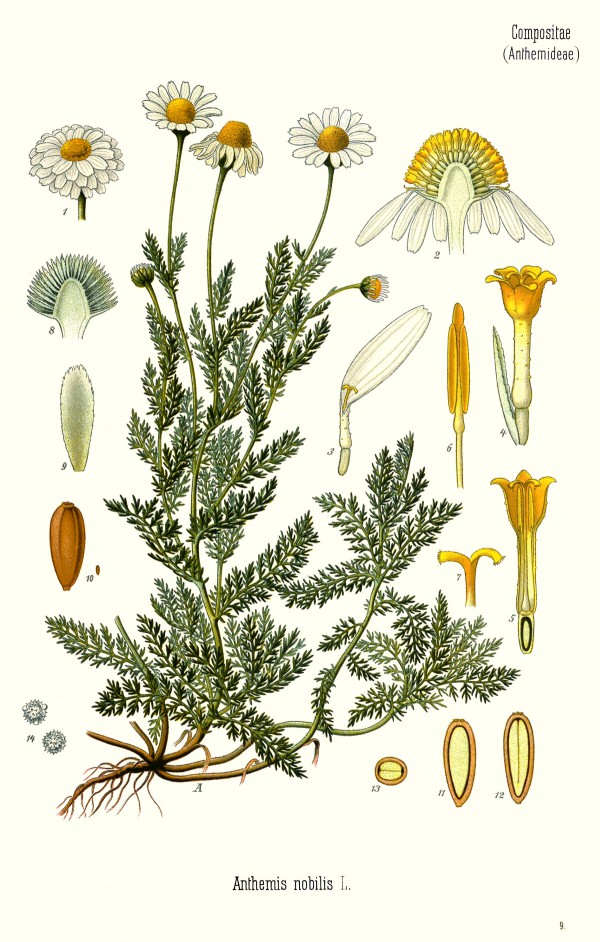Dies ist eine alte Version des Dokuments!
Chamaemelum nobile (L.) All. - syn.Anthemis nobilis L. - Asteraceae
Roman chamomile, English chamomile, Römische Kamille
Perennial herb, 10-30cm tall, native to Europe, West Asia, Northwest Africa; leaves aromatic, hairy, pinnatisect into linear-subulate or filiform segments; ray-florets white, disc-florets yellow.
http://www.efloras.org/florataxon.aspx?flora_id=5&taxon_id=200023646
„In foods and beverages, the essential oil and extract are used as flavor components. In manufacturing, the volatile oil of Roman chamomile is used as a fragrance in soaps, cosmetics, and perfumes; and to flavor cigarette tobacco. The extract is also used in cosmetics and soaps. Teas have been used as a hair tint and conditioner, and to treat parasitic worm infections.“ http://www.nlm.nih.gov/medlineplus/druginfo/natural/752.html
The essential oil of C.nobile from two different regions in Northern Italy showed no significant differences in the composition, characterized by a high content of isobutyl angelate (36.3-38.5%), 2-methylbutyl angelate (18.2-20.3%) and other angelate esters.
[Study on Roman chamomile (Chamaemelum nobile L. All.) oil. Antonelli, A., Fabbri, C., Journal of Essential Oil Research, 10(5), 1998, 571-574]
„The composition of the essential oil obtained by hydrodistillation from the flower heads of Chamaemelum nobile (L.) All. (Asteraceae) was analyzed by capillary GC and GC/MS. Thirty-six components of the oil were identified. The major components were esters, such as isobutyl angelate (21.6%), 2-methylbutyl angelate (14.4%), 2-methyl-2-propenyl angelate (9.1%) and 3-methylamyl angelate (8.4%).“
[Composition of the essential oil from the flowerheads of Chamaemelum nobile (L.) All.(Asteraceae) cultivated in Slovak Republic. Farkas, P., Hollá, M., Vaverková, S., Stahlová, B., Tekel, J., Havránek, E., Journal of Essential Oil Research, 15(2), 2003, 83-85]
„Comparison between hydro-distillation and supercritical fluid extraction (SFE) by CO2 on Anthemis nobilis var. flora plena was investigated. The oil content of flowers extracted by hydro-distillation method was 1.87 and its major components were: isobutyl angelate (25.85%), 2-methyl butyl angelate (13.02%), propyl tiglate (12.00%), isoamyl angelate (6.63%), 3-methylbutyl isobutyrate (5.20%) and isoamyl 2-methylbutyrate (4.08%), and by SFE method were: 2-methyl-butyl angelate (8.59%) isoamyl angelate (4.21%), isoamyl 2-methyl butyrate (2.77%) and propyl tiglate (2.34%). The extraction of the essential oil of Anthemis nobilis var. flora plena by hydro-distillation is recommended.“
[Omidbaigi, R., F. Sefldkon, and F. Kazemi. „Roman chamomile oil: Comparison between hydro-distillation and supercritical fluid extraction.“ Journal of Essential Oil Bearing Plants 6.3 (2003): 191-194]
„The flowers of Roman chamomile (Chamaemelum nobile L. All. var. flora plena) cultivated in Iran were dried by three different drying methods of sun-drying, shade-drying and oven-drying at 40 °C. The essential oils of every treatment were obtained by hydrodistillation of the flowers, and were analysed by GC and GC–MS. The oil content of the shade-dried flowers was the largest (1.9% w/w) compared to sun-drying (0.4% w/w) and oven-drying at 40 °C (0.9% w/w). Drying methods had no effect on the number of chemical components of the essential oil, as 14 components were identified in the oil of every drying method. The major components were isobutyl angelate, 2-methyl butyl angelate, propyl tiglate, isoamyl angelate and 3-methylbutyl isobutyrate.“
[Omidbaigi, R., F. Sefidkon, and F. Kazemi. „Influence of drying methods on the essential oil content and composition of Roman chamomile.“ Flavour and fragrance journal 19.3 (2004): 196-198]
The odor of the steam-distilled essential oil may be described as fruity, pleasant, warm and sweet. Major components are esters of branched C4-C6 alcohols with unsaturated C4/C5 acids like isobutyric, methacrylic, and especially angelic acid. Other compounds are e.g. α-pinene (1.1-9.3%), pinocarveol, pinocarvone, and limonene.
[Wolz, Dietmar, and Gerhard Buchbauer. Aromatherapie in Wissenschaft und Praxis. Ed. Wolfgang Steflitsch. Stadelmann, 2013, 542-545]
„The qualitative and quantitative composition of the main aromatic and polyphenolic constituents of infusion from Chamaemelum nobile flowers was examined. The camomile tea contained a large amount of polyphenolic compounds (340 mg/l), the most important being chamaemeloside (155 mg/l). Only traces of essential oil were recovered in tea (7 mg/l).“
[The aromatic and polyphenolic composition of Roman camomile tea. Carnat, A., Carnat, A. P., Fraisse, D., Ricoux, L., Lamaison, J. L., Fitoterapia, 75(1), 2004, 32-38]

Chamaemelum nobile as Anthemis nobilis
Köhler, F.E., Medizinal Pflanzen, vol.3 t.9 (1890)
http://plantgenera.org/species.php?id_species=1129296
Chamaemelum nobile
© Rolf Marschner (2013),
www.botanische-spaziergaenge.at
